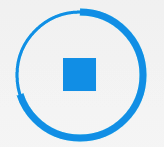Android實現圓線按鈕進度效果
本文實例為大家分享了Android實現圓線按鈕進度效果的具體代碼,供大家參考,具體內容如下
先看效果圖:




這是一個在github上的開源控件按鈕View(點擊此處查看),同時帶有進度。
使用方法:把該項目從github上下載下來導入到eclipse,然后作為庫,接下來在其他項目中直接引用即可。然而,我感覺原生項目中的個別細節代碼不是太完善,我在它的MasterLayout.java類增加了一些字段和方法:
// 增加的值,by Phil public static final int START = 1, PAUSE = 2, COMPLETE = 3; // 增加的方法,by Phil public int getState() { return flg_frmwrk_mode; }
新增加的值和方法主要用于判斷當前View的狀態。
現在給出一個經過我改進后的使用實例:
package zhangphil.progressbutton; import com.thbs.progressbutton.MasterLayout; import android.support.v7.app.ActionBarActivity;import android.view.View;import android.widget.TextView;import android.widget.Toast;import android.os.AsyncTask;import android.os.Bundle;import android.os.SystemClock; public class MainActivity extends ActionBarActivity { private MasterLayout masterLayout; private LongTimeOperationTask mTask; // 顯示進度文字 private TextView tv; @Override protected void onCreate(Bundle savedInstanceState) { super.onCreate(savedInstanceState); setContentView(R.layout.activity_main); masterLayout = (MasterLayout) findViewById(R.id.progress); masterLayout.setOnClickListener(new View.OnClickListener() { @Override public void onClick(View v) { // 必須有該方法,該方法是動畫進度的開始。 // 當用戶點擊該按鈕后立即執行。 masterLayout.animation(); // 此處的判斷代碼是根據當前的View類型判斷的。 // 如果當前View是開始的那個icon,并且用戶點擊了,那么就開始。 // 在次完成用戶的耗時操作,比如下載任務等。 if (masterLayout.getState() == MasterLayout.START) { Toast.makeText(MainActivity.this, '開始...', Toast.LENGTH_SHORT).show(); mTask = new LongTimeOperationTask(); mTask.execute(); } // 用戶點擊了 停止 按鈕。取消任務。 if (masterLayout.getState() == MasterLayout.PAUSE) { if (mTask != null && mTask.getStatus() == AsyncTask.Status.RUNNING) mTask.cancel(true); // reset()是將該空間復位到最初始化的階段。 masterLayout.reset(); Toast.makeText(MainActivity.this, '停止!', Toast.LENGTH_SHORT) .show(); } // 此處的View控件顯示是一個 對號 icon。 if (masterLayout.getState() == MasterLayout.COMPLETE) { Toast.makeText(MainActivity.this, '完成!', Toast.LENGTH_SHORT) .show(); } } }); tv = (TextView) findViewById(R.id.tv); } private class LongTimeOperationTask extends AsyncTask<String, Integer, String> { @Override protected void onPreExecute() { } @Override protected String doInBackground(final String... args) { // 進度以百分制標識。 for (int i = 0; i <= 100; i++) { SystemClock.sleep(100); publishProgress(i); } return null; } @Override protected void onProgressUpdate(Integer... progress) { // 此處的 setupprogress 更新圓形按鈕的進度。 masterLayout.cusview.setupprogress(progress[0]); // 額外的一個TextView顯示進度。 tv.setText(progress[0] + ' %'); } }}
activity_main.xml文件:
<LinearLayout xmlns:android='http://schemas.android.com/apk/res/android' android:layout_width='match_parent' android:layout_height='match_parent' android:orientation='vertical' > <com.thbs.progressbutton.MasterLayout android: android:layout_width='wrap_content' android:layout_height='wrap_content' android:clickable='true' /> <TextView android: android:layout_width='wrap_content' android:layout_height='wrap_content' android:gravity='center' android:text='10%' /> </LinearLayout>
以上就是本文的全部內容,希望對大家的學習有所幫助,也希望大家多多支持好吧啦網。
相關文章:
1. 一篇文章帶你了解JavaScript-對象2. ThinkPHP5 通過ajax插入圖片并實時顯示(完整代碼)3. Python使用oslo.vmware管理ESXI虛擬機的示例參考4. Express 框架中使用 EJS 模板引擎并結合 silly-datetime 庫進行日期格式化的實現方法5. IDEA EasyCode 一鍵幫你生成所需代碼6. Java構建JDBC應用程序的實例操作7. javascript設計模式 ? 建造者模式原理與應用實例分析8. IntelliJ IDEA設置條件斷點的方法步驟9. 使用AJAX(包含正則表達式)驗證用戶登錄的步驟10. python flask框架快速入門

 網公網安備
網公網安備